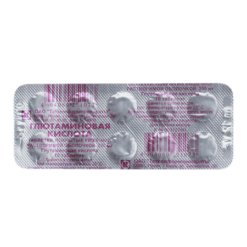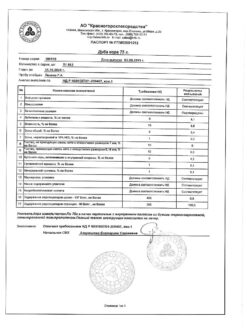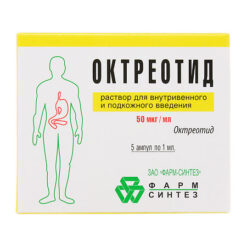No products in the cart.
Rabiet, 10 mg 14 pcs
€12.68 €11.10
EAN: 4605077010257
SKU: 274719
Categories: Medicine, Stomach, intestines, liver, Ulcer and gastritis
Description
Rabeprazole sodium, the active ingredient of Rabiet, belongs to the class of antisecretory compounds, benzimidazole derivatives. It inhibits gastric juice secretion by specifically inhibiting the H+/K+ ATPase on the secretory surface of gastric parietal cells. The H+/K+ ATPase is a protein complex that functions as a proton pump; thus, sodium rabeprazole is a proton pump inhibitor in the stomach and blocks the final stage of acid production.
This effect depends on the dose of rabeprazole and results in suppression of both basal and stimulated acid secretion regardless of the stimulus. The drug has no anticholinergic properties.
Antisecretory effects
After oral administration of rabeprazole sodium at a dose of 20 mg, the antisecretory effect develops within 1 hour. Inhibition of basal and stimulated acid secretion 23 hours after the first dose of sodium rabeprazole is 69% and 82% respectively and continues up to 48 hours. This duration of pharmacodynamic action is much longer than that predicted by the half-life (T1/2) (approximately 1 hour).
This effect can be explained by prolonged binding of the drug substance to H+/K+ ATPase of gastric parietal cells. The magnitude of the inhibitory effect of rabeprazole sodium on acid secretion reaches a plateau after three days of taking rabeprazole sodium. When discontinued, secretory activity is restored within 1-2 days.
The effect on plasma gastrin levels
In clinical studies, patients took 10 or 20 mg of rabeprazole sodium daily for a treatment duration of up to 43 months. Plasma gastrin concentrations were elevated for the first 2 to 8 weeks, reflecting an inhibitory effect on acid secretion. Gastrin concentrations returned to baseline levels usually within 1-2 weeks after discontinuation of treatment.
The effect on enterochromaffin-like cells
. When human gastric biopsy specimens from the antrum and fundus of the stomach of 500 patients who received rabeprazole sodium or a comparison drug for 8 weeks were examined, no consistent changes were found in the morphological structure of enterochromaffin-like cells, the severity of gastritis, the frequency of atrophic gastritis, intestinal metaplasia or the spread of Helicobacter pylori infection.
In a study involving more than 400 patients receiving rabeprazole sodium (10 mg/day or 20 mg/day) for up to 1 year, the incidence of hyperplasia was low and comparable to that of omeprazole (20 mg/kg). No cases of adenomatous changes or carcinoid tumors were reported in rats.
Systemic effects of rabeprazole sodium on the central nervous system, cardiovascular or respiratory systems have not been reported at this time. Rabeprazole sodium has been shown to have no effect on thyroid function, carbohydrate metabolism, blood concentration of parathyroid hormone, and concentrations of cortisol, estrogen, testosterone, prolactin, glucagon follicle stimulating hormone (FSH), luteinizing hormone (LG), renin, aldosterone and somatotropic hormone when taken orally in a dose of 20 mg for 2 weeks.
Indications
Indications
– peptic ulcer in the acute phase and anastomosis ulcer;
– acute phase duodenal ulcer;
– erosive and ulcerative gastroesophageal reflux disease or reflux esophagitis;
– maintenance therapy for gastroesophageal reflux disease;
– non-erosive gastroesophageal reflux disease;
– Zollinger-Ellison syndrome and other conditions characterized by pathological hypersecretion;
– in combination with appropriate antibacterial therapy to eradicate Helicobacter pylori in patients with peptic ulcer disease.
Active ingredient
Active ingredient
Composition
Composition
1 capsule contains:
rabeprazole,
substance-pellet 8.5% 118 mg
acting substance:
rabeprazole sodium 10 mg;
auxiliary substances:
sugar spheres (sucrose 99.83%, novidone 0.17%) 71.46 mg,
sodium carbonate 1.66 mg,
talc 1.77 mg,
titanium dioxide 0.83 mg,
Hypromellose 14.75 mg;
Pellet shell excipients:
Hypromellose phthalate 15.94 mg, cetyl alcohol 1.59 mg;
solid gelatin capsule #3:
capsule body – titanium dioxide 2%,
gelatin to 100%;
capsule cap – titanium dioxide 2%,
Patented blue dye 0.0176 %,
dye diamond black 0.0051 %,
gelatin to 100%.
How to take, the dosage
How to take, the dosage
The drug is taken orally, preferably in the morning, before meals. It is established that neither time of day nor food intake influences the activity of rabeprazole sodium, but recommended time of taking rabeprazole promotes better adherence of patients to the treatment regimen. The capsules should be swallowed whole without chewing or crushing.
The recommended dose is 10 mg once daily.
If there is no effect within the first 3 days of treatment, a specialist should be seen.
The maximum course of treatment without a physician’s consultation is 14 days.
Interaction
Interaction
The cytochrome 450 system
Sodium rabeprazole, like other proton pump inhibitors, is metabolized with participation of the cytochrome P450 system (CYP450) in the liver. In in vitro studies on human liver microsomes it was shown that rabeprazole sodium is metabolized by CYP2C19 and CYP3A4 isoenzymes.
Studies in healthy volunteers have shown that rabeprazole sodium has no pharmacokinetic or clinically significant interactions with drugs that are metabolized by the cytochrome P450 system – warfarin, phenytoin, theophylline and diazepam (regardless of how diazepam is metabolized in patients, either heavily or weakly).
There was a study of combination therapy with antibiotics. This four-way study involved 16 healthy volunteers who received 20 mg of rabeprazole, 1,000 mg of amoxicillin, 500 mg of clarithromycin or a combination of these three drugs (RAC – rabeprazole, amoxicillin, clarithromycin).
The AUC and Cmax values for clarithromycin and amoxicillin were similar when comparing combination therapy to monotherapy. The AUC and Cmax for rabeprazole increased by 11% and 34%, respectively, and the AUC and Cmax for 14-hydroxyclarithromycin (the active metabolite of clarithromycin) increased by 42% and 46% for combination therapy compared with monotherapy, respectively. This increase in the effects of rabeprazole and clarithromycin was not found to be clinically significant.
Interactions due to inhibition of gastric juice secretion
Rabeprazole sodium has sustained and prolonged suppression of gastric juice secretion. Thus, there may be an interaction with substances for which absorption is pH-dependent. When concomitant administration with rabeprazole sodium, absorption of ketoconazole is reduced by 30%, and absorption of digoxin is increased by 22%. Consequently, for some patients observation should be carried out to decide whether it is necessary to adjust the dose when concomitant use of rabeprazole sodium with ketoconazole, digoxin or other drugs for which absorption depends on pH.
Atazanavir
Concomitant administration of atazanavir 300 mg/ritonavir 100 mg with omeprazole (40 mg once daily) or atazanavir 400 mg with lansoprazole (60 mg once daily) in healthy volunteers showed a significant decrease in atazanavir exposure. Atazanavir absorption is pH dependent. Although concomitant administration with rabeprazole has not been studied, similar results are also expected for proton pump inhibitors. Thus, concomitant use of atazanavir with proton pump inhibitors, including rabeprazole, is not recommended.
Antacids
In clinical trials antacids were used together with rabeprazole sodium. No clinically significant interaction of rabeprazole sodium with aluminum hydroxide gel or magnesium hydroxide was observed.
In a clinical study, no clinically significant interaction was observed during administration of rabeprazole sodium with fat-dense food. Administration of rabeprazole sodium concomitantly with fat-rich food may delay absorption of rabeprazole up to 4 hours or more, but Cmax and AUC are not changed.
Cyclosporine
In vitro experiments using human liver microsomes showed that rabeprazole inhibited the metabolism of cyclosporine with an IC50 of 62 μmol, i.e. at a concentration 50 times the Cmax for healthy volunteers after 20 days of rabeprazole dosing of 20 mg. The degree of inhibition is similar to that of omeprazole for equivalent concentrations.
Methotrexate
. According to reports of adverse events, data from published pharmacokinetic studies, and data from retrospective analysis, it can be assumed that concomitant administration of proton pump inhibitors and methotrexate (especially in high doses) may lead to increased concentration of methotrexate and/or its metabolite hydroxy-methotrexate and prolong its elimination time. However, special studies of drug interaction of methotrexate with proton pump inhibitors have not been conducted.
Special Instructions
Special Instructions
Patient response to therapy with rabeprazole sodium does not exclude the presence of gastric malignancy.
In a special study in patients with mild to moderate hepatic impairment no significant difference in the incidence of side effects of rabeprazole was found compared to that in gender- and age-matched healthy subjects, but despite this, caution is recommended when first using Rabiet® in patients with severe hepatic impairment.
Patients with impaired renal or hepatic function do not require dose adjustment of Rabiet®. The AUC of rabeprazole sodium in patients with severe hepatic impairment is approximately 2 times higher than in healthy patients.
Hypomagnesemia
When treated with proton pump inhibitors for at least 3 months, cases of symptomatic or asymptomatic hypomagnesemia have rarely been reported. In most cases, these reports came one year after therapy. Serious adverse events were tetany, arrhythmias, and seizures.
The majority of patients required treatment for hypomagnesemia, which included magnesium replacement and proton pump inhibitor withdrawal. In patients who will receive long-term treatment or who take proton pump inhibitors with drugs such as digoxin or drugs that may cause hypomagnesemia (e.g., diuretics), magnesium concentrations should be monitored before treatment with proton pump inhibitors and during treatment.
Do not take other acid reducing agents such as H2-histamine receptor blockers or proton pump inhibitors concomitantly with Rabiet®.
Bone fractures
Observational studies suggest that therapy with proton pump inhibitors may increase the risk of osteoporosis-related fractures of the hip, wrist, or spine. The risk of fracture was increased in patients who received high-dose proton pump inhibitors for a long period of time (one year or more). High should be understood to mean doses higher than those recommended in the instructions.
Concomitant use with methotrexate
According to the literature, concomitant use of proton pump inhibitors with methotrexate (especially in high doses) may lead to increased concentration of methotrexate and/or its metabolite hydroxytetrexate and prolong its elimination time, which may lead to methotrexate toxicity. Temporary discontinuation of therapy with proton pump inhibitors may be considered if high doses of methotrexate are necessary.
Clostridium difficile
Therapy with proton pump inhibitors may lead to an increased risk of gastrointestinal infections such as those caused by Clostridium difficile.
Patients taking rabeprazole for short-term symptomatic treatment of manifestations of GERD and NERD (e.g., heartburn) without a prescription should consult a physician in the following cases:
– use of medications to relieve symptoms of heartburn and digestive disturbances for 4 weeks or more;
– occurrence of new symptoms or changes in previously observed symptoms in patients over 55 years of age;
– cases of unintentional weight loss, anemia, gastrointestinal bleeding, dysphagia, pain when swallowing, persistent vomiting or vomiting with blood and gastric contents, history of gastric ulcers or gastric surgery, jaundice, etc.д. (including impaired liver and kidney function).
Patients with recurrent symptoms of digestive disorders or heartburn should be regularly monitored by a physician. Patients over 55 years of age who take daily over-the-counter medications to relieve symptoms of heartburn and digestive disorders should inform their physician.
Do not take other acid-reducing drugs, such as H2-histamine receptor blockers or proton pump inhibitors, at the same time as rabeprazole.
Patients should consult their pharmacist or physician before starting over-the-counter therapy with Rabiet® when using other drugs.
Patients should tell their physician before starting Rabiet® without a prescription if they are scheduled for an endoscopic exam.
Patients should avoid taking Rabiet® prior to performing a urea breath test.
Patients with severe hepatic impairment should see their physician before starting over-the-counter therapy with Rabiet® for short-term symptomatic treatment of GERD and NERD symptoms (e.g., heartburn).
Influence on driving and operating machinery
Based on peculiarities of pharmacodynamics of rabeprazole and its profile of adverse effects, it is unlikely that rabeprazole affects the ability to drive and operate machinery. However, in case of drowsiness, these activities should be avoided.
Contraindications
Contraindications
– Sucrose/isomaltase deficiency, fructose intolerance, glucose-galactose malabsorption syndrome;
– pregnancy;
– period of breastfeeding;
– age under 18 years;
– hypersensitivity to rabeprazole, substituted benzimidazoles or to the excipients of the drug.
The drug should be used with caution in severe renal failure.
Side effects
Side effects
Based on the experience of clinical studies, it can be concluded that rabeprazole is usually well tolerated by patients. Side effects are generally mild to moderate and transient.
The following side effects have been reported with rabeprazole in clinical trials.
Nervous system disorders: headache, dizziness.
Digestive system disorders: abdominal pain, diarrhea, flatulence, constipation, dry mouth.
Others: rash, peripheral edema.
The following side effects have been reported during post-registration use of the drug.
Digestive system disorders: increased activity of liver enzymes; rarely – hepatitis, jaundice. In patients with liver cirrhosis the development of hepatic encephalopathy has been rarely reported.
Hematopoietic system: rare – thrombocytopenia, neutropenia, leukopenia.
Muscular system: rare – myalgia, arthralgia.
Allergic reactions: rare – bullous rashes, urticaria, acute systemic allergic reactions; very rare – erythema multiforme, toxic epidermal necrolysis, Stevens-Johnson syndrome.
Others: rare – hypomagnesemia; very rare – development of interstitial nephritis, gynecomastia.
There were no changes in other laboratory parameters during administration of Rabeprazole sodium.
According to post-marketing surveillance data, proton pump inhibitors may increase the risk of fractures.
Overdose
Overdose
The data on intentional or accidental overdose are minimal.
There have been no cases of severe overdose of rabeprazole.
Treatment: conduct symptomatic and supportive therapy.
The specific antidote for rabeprazole is unknown.
Rabeprazole binds well to plasma proteins, so it is poorly excreted by dialysis.
Similarities
Similarities
Additional information
| Weight | 0.017 kg |
|---|---|
| Shelf life | 2 years |
| Conditions of storage | In a light-protected place at a temperature not exceeding 25 °C. |
| Manufacturer | Obolenskoe FP JSC, Russia |
| Medication form | enteric capsules |
| Brand | Obolenskoe FP JSC |
Related products
Buy Rabiet, 10 mg 14 pcs with delivery to USA, UK, Europe and over 120 other countries.













